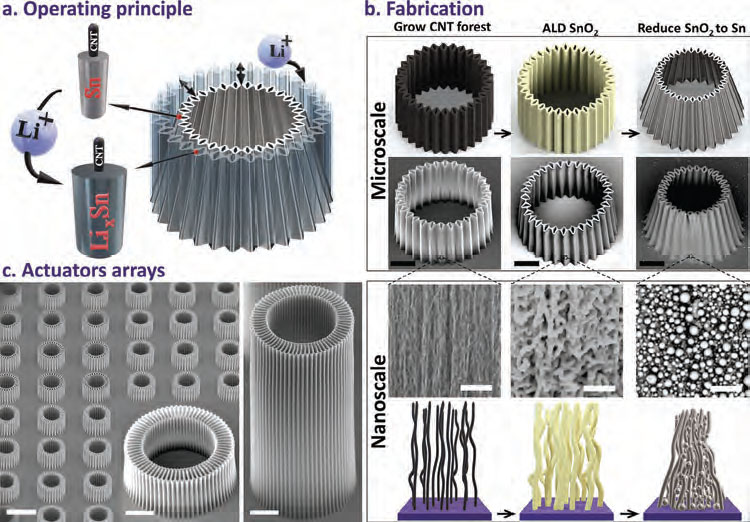| Dec 06, 2023 | |
3D Electrochemically active nanostructures advance responsive material design |
|
| (Nanowerk Spotlight) Scientists have long worked to develop responsive materials capable of reshaping themselves in controlled ways, aiming to enable applications from soft robotics to camouflage. However, previous efforts confronted barriers including limitations in scalable manufacturing, complexity of achievable shape change, reversibility across repeated actuation cycles, and seamless integration of control mechanisms. | |
| Now, researchers from the University of Cambridge introduce responsive carbon nanotube-tin (CNT-Sn) composites able to reshape based on programmed electrical cues. By employing lithography-founded fabrication, the team produced intricate 3D microstructures across wafer-ranges. Through an electrochemical alloying and de-alloying process, these tiny elements reshape in a non-volatile manner over 70+ cycles. | |
| The team published their findings in Advanced Materials ("Electrochemically Responsive 3D Nanoarchitectures"). | |
 |
|
| Actuation mechanism and wafer-scale fabrication of 3D microstructures: a) Schematic of the electrochemical alloying reaction of Li–Sn and resulting volumetric expansion at nano/microscale. This non-volatile and reversible process is controlled by simple electrical current. b) Schematic of the different steps in fabrication process of the CNT/Sn 3D microstructures at nano and micro scales (top rows) with their corresponding SEM images (lower rows). c) The SEM image of the 3D microstructures arrays fabricated by CVD growth of vertically aligned CNT forests with complex geometries from 2D patterns. (c, inset) CNT forests with varying heights ranging from microns to millimeter with growing speed of ≈100 µm min−1. The SEM imaging is carried out at 45° tilt angle; scale bars: (b, top row), 50 μm; (b, lower row), 2 µm (c) 200 µm; (c, inset), 100 µm. (Reprinted with permission by Wiley-VCH) | |
| Previous shape-changing systems often relied on soft active materials like stimuli-responsive polymers or hydrogels. However, leveraging the extreme tensile strength of CNT scaffolds, the Cambridge group achieved expansions similar to polymers with the higher stiffness of tin. This amplifies the resulting actuation and opens new possibilities in micro-electromechanical and optically adaptive systems. | |
| Their manufacturing method also moves beyond previous specialized techniques with low throughput. Instead, by integrating carbon nanotube growth and atomic layer deposition, thousands of responsive pixels can be produced in parallel. | |
| The hybrid material works by lithiating tin through a simple electrical current, causing it to swell up to 250% in a spontaneous alloying reaction. This reshaping is achieved through an electrochemical process where lithium ions intercalate into the tin, fundamentally altering its volume. The physical expansion of tin, driven by this electrochemical process, exerts force on the carbon nanotubes, enabling their controlled actuation. | |
| The swelling pushes on stiff, vertically aligned CNTs, programmed into intricate cone or lattice shapes. The electronically controlled and continuously variable transformation is maintained after removing the stimulus. Cycling is achieved by reversing the process through de-lithiation. These capabilities come from fundamental battery principles but at smaller scales for micrometer-range actuation. | |
| Through simulation-guided design, the researchers created responsive, electrochromic structures optimized for large, lateral shape change rather than excessive height shifts. Modulating geometric parameters and sidewall patterns, an over 95% expansion was achieved. The resulting strokes reached up to ten times those of earlier reports based on softer active gels. Stability was demonstrated across 70+ cycles and electrochromic switching could camouflage the reversible movements. | |
| After detailing the significant advances and potential applications of these responsive nanoarchitectures, it's also important to acknowledge the challenges that remain. The paper notes the air-sensitivity of the CNT-Sn system, which presents a hurdle for long-term durability in real-world environments. This aspect emphasizes the need for further research in developing more robust materials and sealing methods to enhance the longevity and practical usability of these structures. | |
| Additionally, while the scalability of the manufacturing process is a major breakthrough, the integration of these materials into existing technological platforms may require additional adaptations. Addressing these challenges will be crucial for fully realizing the transformative potential of this technology in applications such as interactive surfaces and microscale devices. | |
| In the future, vast arrays of these dynamic pixels could cover interactive surfaces for heat regulation, light manipulation, or active camouflage. Microscale robotic cilia are another possibility, as are miniature pumps or valves for labs-on-a-chip. | |
| This breakthrough offers exciting prospects in miniaturizing micro-electromechanical systems (MEMS), potentially revolutionizing small-scale device technology. | |
| The simplicity of electrical control and compatibility with electronics integration should propel applications. New sealing methods will likely be needed for longevity in real-world settings. Nonetheless, by bringing together scalable manufacturing and battery-inspired actuation, this advance provides a starting point to transform fields relying on responsive motions. | |
| In essence, this research marks a significant stride in the evolution of responsive materials, bridging the gap between theoretical promise and practical application. | |
 By
Michael
Berger
– Michael is author of three books by the Royal Society of Chemistry:
Nano-Society: Pushing the Boundaries of Technology,
Nanotechnology: The Future is Tiny, and
Nanoengineering: The Skills and Tools Making Technology Invisible
Copyright ©
Nanowerk LLC
By
Michael
Berger
– Michael is author of three books by the Royal Society of Chemistry:
Nano-Society: Pushing the Boundaries of Technology,
Nanotechnology: The Future is Tiny, and
Nanoengineering: The Skills and Tools Making Technology Invisible
Copyright ©
Nanowerk LLC
|
|
|
Become a Spotlight guest author! Join our large and growing group of guest contributors. Have you just published a scientific paper or have other exciting developments to share with the nanotechnology community? Here is how to publish on nanowerk.com. |
|
